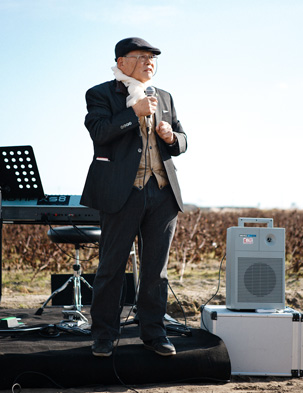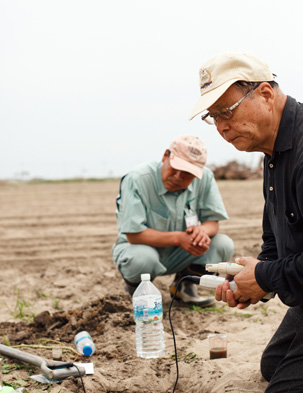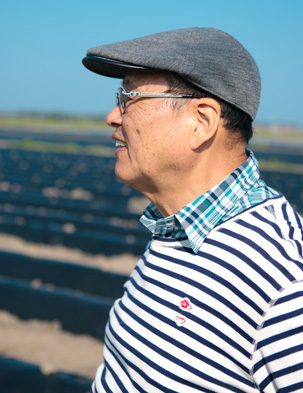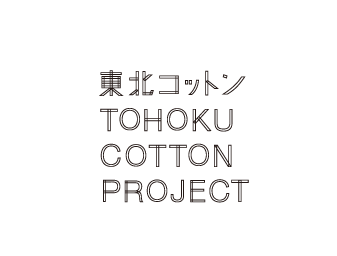
For about twenty years, I’ve been creating cotton fields and building spinning mills in twenty-eight countries worldwide. In 1989, I read an article by Dr. Sally Fox, an advocate of the organic cotton industry, and went to meet her. This changed my life immensely. I believe that spreading the word about organic cotton will lead us closer to world peace, and I’ve committed myself to building factories that value people and life. In addition to this, I’ve supported the restoration of land damaged by tsunamis and tidal waves worldwide by growing cotton.
However, I wasn’t doing anything for Japan during those twenty years. That’s why, when the disaster struck, I thought – this is my calling. It’s time to help Japan. The resistance of cotton to sodium truly is a blessing.
When the earthquake hit on March 11th, I was on a business trip in Nice, France. At the end of April, I went to Sendai (prefecture in Northeast Japan); at that point, I hadn’t yet decided to grow cotton there. But seeing the way the wells were broken, and the state of the irrigation equipment – I thought to myself, it would be five to eight years before rice harvest could resume. The farmers would end up with no income if we didn’t do something. There wasn’t yet another way out, so it seemed quite clear to me that we had to start growing cotton.

The first thing we did was to measure the sodium concentration of the soil. The Pacific Ocean contains 3.5%, and this soil had been soaking in its water for two to four weeks. The roots of the cotton plant grow to 50cm beneath the surface, so we took random samples of the sodium concentration within this range. The results were 0.8% - 1.0%, and we figured that we had a chance. Rice can only withstand 0.2%, and soybeans 0.1%, but cotton had been known to grow in soil containing up to 1.5% sodium.
I then spoke at the “Cotton CSR Summit”, which took place on May 10th. I was had been invited to discuss the definition of ethical fashion, but I asked for five minutes to talk about saving Tohoku with cotton flowers. Everybody clapped and said, “Let’s work together on this”.
We were lucky to have the right people to set up this project. I hadn’t actually proposed that we work together on it. I’d said: I’m about to start planting some cotton, so you apparel guys, would you like to buy it from me? Then, everyone started to say, let’s do it together. They’re all so passionate. They’ve all got beautiful hearts. They all have love and compassion for Tohoku, and it has made me so happy. I won’t let down the people who have supported us.
Right now in Japan, there are 400,000 hectares (400km 2) of unused land, and it’s said that half of that land is in Tohoku. My wish is to turn all of that land into cotton fields – but once the sodium has leached out of the damaged paddy fields, I’d like it if they could go back to growing rice. We all want to eat Hitomebore rice again, after all.
At the same time, I think we might be able to start a whole new industry with cotton. If we run this project properly, cotton will lead to profits, and we can ensure the safety and reliability of ‘Made in Japan’ products. Nobody in the area knew how to produce cotton before, and that’s where I came in. I said, let’s build a spinning mill and a power loom factory; if we combine these, we’ve got a place of work in Tohoku. My job really has been to build an industrial estate for 50,000 people in a place where people have traditionally harvested rice.

I’m just so full of gratitude. I want to say thank you to all the people who have worked with us. Thank you, to the cotton flowers that have bloomed – even though people said they wouldn’t, with the cool climate in Tohoku.
What makes me happiest is the stories of the people in the evacuation centres. They have told me that they look forward to going to the fields in the morning, to look at the flowers. The plants grow, the flowers bloom, and cotton balls burst – these are the small joys of their lives.
We’re facing a huge challenge right now, but what comes next is happiness. Let’s not just start a new industry in the Tohoku, but lead the way in the economic recovery of Japan during the global recession. We engineers couldn’t possibly complain, working towards a goal like that. It’s clear what we’ve got to do.
(October 26, 2011)
Translation Volunteer : Kei Hamada











